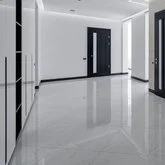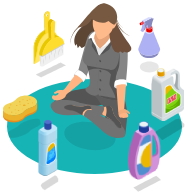
Floor Cleaning: Best Practice & Compliance
One of the first impressions an employee or customer receives when entering a building is the condition and state of the floor. Well-maintained floors are clean, attractive and safe, creating a favourable impression that reflects well on both the company and building owners.
Despite this, floors remain a key hazard area for businesses. Slips and trips are the most common cause of injury at work, occuring when floors become contaminated or wet and many trips result from poor housekeeping. From all reported injuries that happen to members of the public within workplaces (this includes businesses such as in hospitals, shops and restaurants), 50% were the result of slips and trips. It is the employers responsibility for controlling risks from slips and trips, including undertaking workplace risk assessments.
The cleaning function of a business plays a key role in controlling these risks, whilst ensuring all that all staff adopt a “see it, sort it” attitude, helps to create a safer workplace. This includes:
- Prevent floors from getting wet or contaminated in the first place. Where dispensers are in place, use a drip tray to prevent spills.
- Encourage good housekeeping practices with all staff. All workplaces should be kept clear with no trailing cables and dispose of all packaging material and wrappings carefully – don’t leave these lying around on the floor. Magazines and newspaper inserts can be slippery – monitor, remove and recycle promptly if these fall onto the floor.
- Always use wet floor signs.
Stay Connected
Want to hear more from The Cleaning Collective? Sign up to our mailing list for the latest offers and news

How to Clean Floors
Suitable and timely cleaning regimes are important for controlling contamination on flooring and keeping floors clean, and procedures should be introduced for both response and routine cleaning. Contamination is often bought inside on footwear, with the type of contamination being dependent on the local environment (such as sand around beach resourts or mud in the countryside). Contamination can also be caused by spills.
Depending on your floor type, there are a number of steps required to keep your floor maintained and in good order:
Polished Floors
- Strip and Polish
Frequency: Least often
Floors that require polishing should have a periodic “strip and polish”. A restorative procedure, first a "strip and polish" removes current layers of polish and dirt from the floor using a special cleaning chemical to take the surface back to its original state. This is followed by the application of fresh coats of polish to restore and revive the floor. - Scrub and Recoat
Frequency: Semi-regularly
Once restored, the floor should be given a regular “scrub and recoat” to maintain the finish. This is achieved by scrubbing the floor and then applying polish to bring back the required shine. This keeps the floor looking brilliant between each “strip and polish”.
You can normally tell when a “strip and polish” is required as either a “scrub and recoat” will no longer bring your floor back to its shiny best, or the floor is shiny, but looks dirty, as contaminants have been trapped between each layer of polish.
Floor polish may contain properties that makes flooring more slip resistance, therefore improving grip when people walk across the surface. - Maintenance Clean
Frequency: Regularly
Finally, a floor maintainer is used for regular cleaning to remove dirt and grime, keeping it both safe by limiting slip potential from contaminants and also looking great. - Spills
Frequency: Clean-as-you-go
If a spillage occurs, clean this up quickly. Sanitaire Clean Up Powder can absorb up to 200 times its own weight and is suitable for cleaning-up body fluids such as vomit, urine and blood, as well as food and drink spills. Once the spill is absorbed into the powder it can be easily scooped and disposed of.
An example is given below on how a floor cleaning schedule might look:
- Strip and polish: Yearly
- Scrub and recoat: Monthly
- Maintenance clean: Daily
- Spills: Clean-as-you-go
Please note, this schedule is an example and is not suitable for all businesses. Frequencies are determined by the type of flooring, amount of footfall, the type of contaminants (such as sand from a beach or mud in the countryside) and also the required finish (a high shine will require more frequent polishing). This should be determined on a business-by-business basis in line with risk assessments.
For more information on slips and trips in the workplace visit the HSE website by clicking here and to find floor cleaning products to help maintain your floors click here.
Been wondering "where can I find trade cleaning supplies near me"? Look no further, and get your products delivery direct to your door from The Cleaning Collective. We also stock bulk cleaning products for your home too.
Stay Connected
Stay connected and be the first to know about our latest products, special offers, and exciting news:The Cleaning Blog
Want to learn more about cleaning? From the latest cleaning and hygiene news to handy how-to guides, why not check out our most popular blog categories.Stay Connected
Stay connected and be the first to know about our latest products, special offers, and exciting news:











